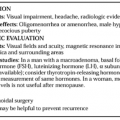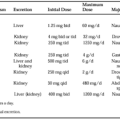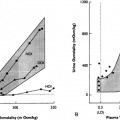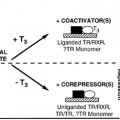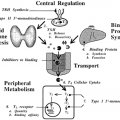NORMAL IMAGING ANATOMY
SKULL RADIOGRAPHS
An evaluation of subtle changes of the bony architecture of the sella is not of great clinical use because there are many normal variations in the size, shape, and cortical margins of the sella. In part, this is due to differences in the configuration of the sphenoid bone and sphenoid sinus. It is important to realize that variations in the shape of the sella do not always reflect the pathology of the adjacent structures.
The sella is usually evaluated with lateral and posteroanterior plain radiographs (tomography has been largely replaced by CT). On the lateral projection, the sella turcica is a È-shaped structure that is seen as a crisp, dense cortical bone margin (see Fig. 20-1). Those segments of the sella that are outlined by the underlying air spaces of the sinuses exhibit a thin cortical margin, which is referred to as the lamina dura. If the sinus is opacified or not pneumatized and filled with bone marrow, the sellar margin is thicker.
The planum sphenoidale is a flat, thin bone that forms the roof of the anterosuperior sphenoid sinus and extends posteriorly to terminate in the anterior clinoid processes. Between the anterior clinoid processes, the planum sphenoidale ends at a small arc-shaped ridge of bone called the limbus; this forms the anterior margin of a small bony depression called the chiasmatic sulcus (which conforms to the optic chiasm and nerves). This concavity is where the optic chiasm divides into the optic nerves. The lateral margins of the chiasmatic depression extend into the optic canals that, in turn, extend anteriorly and laterally. Superior to the optic canals are the anterior clinoids, which are visible on lateral radiograph. The inferoposterior margin of the chiasmatic sulcus is the tuberculum sella, which forms the most anterior and superior margin of the sella turcica (hypophyseal fossa). The diaphragma sellae is the superior dural covering of the sella that extends from the tuberculum sella to the posterior clinoids. It cannot be seen on plain radiographs, but marks the true roof of the sella turcica. Usually, the floor of the sella is not perfectly hemicircular in configuration, but is more oval in shape. The normal range of dimensions of the bony sella from anterior to posterior on lateral radiograph is 5 to 16 mm, with a mean of 10.6 mm. The normal range of dimensions in depth is 4 to 12 mm, with a mean of 8.1 mm.7
The anteroposterior projection of the sella usually is less informative than the lateral, but it may be useful in defining the lateral margins of the sphenoid sinus and the floor of the sella. The floor of the sella frequently bows inferiorly slightly. Septations of the sphenoid sinus are frequently seen and may account for variations in the shape of the sella and pituitary gland.
COMPUTED TOMOGRAPHIC IMAGING
On CT, bone and calcified structures have a high density (similar to that seen in plain radiographs), whereas the air spaces are of low density. The CSF spaces are of intermediate density, with the fat structures (such as periorbital fat) being lower in density than the CSF. The brain and pituitary gland usually have a slightly higher density than the CSF. With the use of intravenous contrast agents, the blood vessels, cavernous sinus, pituitary gland, and pituitary stalk all enhance intensely, thus increasing their apparent density (see Fig. 20-2). This helps define the pituitary gland and the cranial nerves in the cavernous sinus. Rarely, intrathecal contrast is used for the evaluation of a CSF fistula.
In general, contrast-enhanced direct coronal CT images of the sella are the most informative, although axial sections are easier for patient positioning. If one is not able to perform direct coronal imaging, computer reconstructions of axial images into sagittal and coronal sections can be obtained, although their detail is limited. On coronal CT, the bony sella is seen as a flat to minimally concave structure with the sphenoid sinus directly inferior (see Fig. 20-2A). The lateral walls of the sella are formed by the cavernous sinuses, which are visualized on enhanced CT as contrast-filled structures bounded laterally by dura. The individual cranial nerves (oculomotor, abducens, and trochlear) can be seen in the cavernous sinus. Meckel cave, which is a CSF space extending from the posterior fossa, contains the fifth cranial nerve. The dural margins of the cave enhance, while the CSF spaces are seen as low-density, vertical, oval cavities.
Stay updated, free articles. Join our Telegram channel

Full access? Get Clinical Tree



